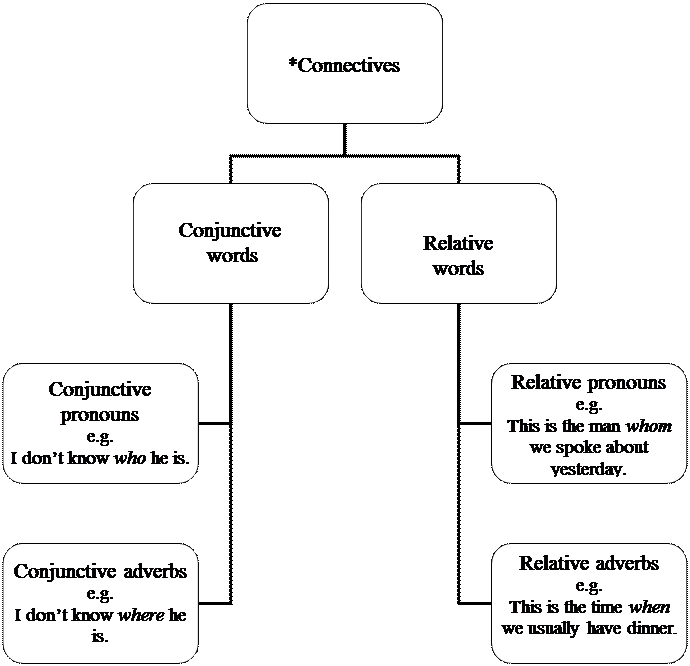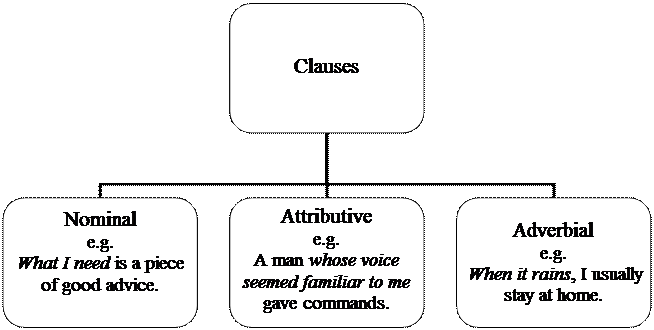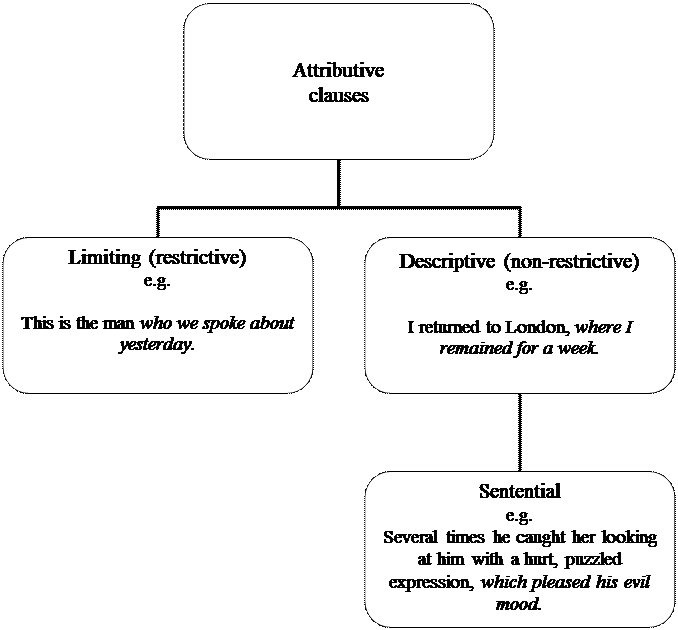In accord with the functional principle,subordinate clauses are to be classed on the analogy of the positional parts of the simple sentence. Subordinate clauses function as different parts of the sentence (subject, predicative, object, apposition, attribute, adverbial modifier).Traditionally these numerous types of clauses are arranged in three groups: nominal clauses (that is, clauses functioning as nouns in various syntactical positions), attributive clauses, and adverbial clauses (Fig. 148).

Fig. 147
All nominal clauses have a function approximating to that of a noun or a nominal phrase. They may fulfill the function of a basic part of the main clause: a subject clause functions as subject of the main clause which has no subject of its own, a predicative clause functions as predicative to the link verb within the main clause; an object clause refers to verbs in different forms and functions, to adjectives, statives and occasionally to nouns, and may be obligatory or optional (Fig. 149). All nominal clauses are very closely connected with the main clause, and if such a clause is removed, both the structure and meaning of the sentence are changed or become ungrammatical.

Fig. 148

Fig. 149
Attributive clauses function as modifiers to a word of nominal character, which is generally called the antecedent. Usually an attributive clause immediately follows its antecedent, although some types may occasionally be distant.
An attributive clause may be introduced by connectives – relative pronouns (who, whose, whom, what, which, that, as), or relative adverbs (when, where, whence, wherein). The choice of relative word depends on the categorical meaning of the antecedent.
Attributive clauses fall into two types, depending on the degree of connection and the relation they bear to the antecedent (Fig. 150).

Fig. 150
Attributive limiting clauses are very closely connected with the antecedent and cannot be removed from the sentence, because the information contained in the attributive clause singles out, determines, or particularizes the person, thing, idea, etc., expressed by the antecedent. Therefore the meaning of the main clause is not complete or is altogether changed without the subordinate clause. The lack of completeness is manifested by somedeictic elements (determinants) before the antecedent (mainly articles, demonstrative pronouns, or words with a demonstrative or particularizing meaning, such as the same, the only, the best). The presence of such elements is justified only if the attributive clause is following.
In these sentences the main part taken separately is not clear because of the article which has a classifying or a demonstrative force and therefore requires some explanation in the form of an attributive clause or some context to make explicit what kind of place the library was, what fact was meant.
Attributive descriptive clauses are characterized by a looser connection with the main clause. Usually they contain additional information about the antecedent and may be left out without any serious change in the meaning of the main clause.
Attributive descriptive clauses are generally comma off. They are joined by the same connectives as limiting clauses, except the relative pronoun that, and asyndetic connection hardly ever occurs. The additional descriptive character of the attributive clause is determined by the fact that the antecedent denotes a definite person, place, thing, notion, etc. It is either specified by a limiting attribute, or is expressed by a proper name, or else denotes a unique notion (or one specified by the situation).
An attributive descriptive clause referring to a whole clause, sentence, series of sentences, or even a whole story is called a continuative (or sentential) attributive clause. It is generally introduced by the connective which, occasionally by that.
Adverbial clauses are usually classified according to their meaning, that is, according to the relation they bear to the main clause. They differ from nominal and attributive clauses in that they are introduced by conjunctions with a more distinct meaning.
Some types of adverbial clauses may be introduced by at least a dozen different conjunctions (as for instance adverbial clauses of time). On the other hand, many of the conjunctions are used to introduce more than one kind of clause (as, since, that, when, now that). In some cases the meanings and functions of the conjunction are so numerous that it is really difficult to say what the basic meaning of the conjunction is, as its function depends on the meaning of the clauses and their relationship.
Conditional clauses may be joined asyndetically, though they have link-inversion in this case. Here the meaning and function of the clause can be inferred only from the meaning of the subordinate and the main clause.
An adverbial clause may qualify the whole main clause, the verbal predicate or any verbal part, and also parts expressed by an adjectiveoradverb. Its position therefore varies: it may be initial, medial, or final – depending on the position of the part of the sentence it refers to and on the general structure of the main clause.
According to their semantics several types of adverbial clause are distinguished (Fig. 151).
Fig. 151

In accord with the categorial principle, subordinate clauses аre to be classed by their inherent nominative properties irrespective of their immediate positional relations in the sentence (Fig. 152). The nominative properties of notional words are reflected in their part-of-speech classification.






